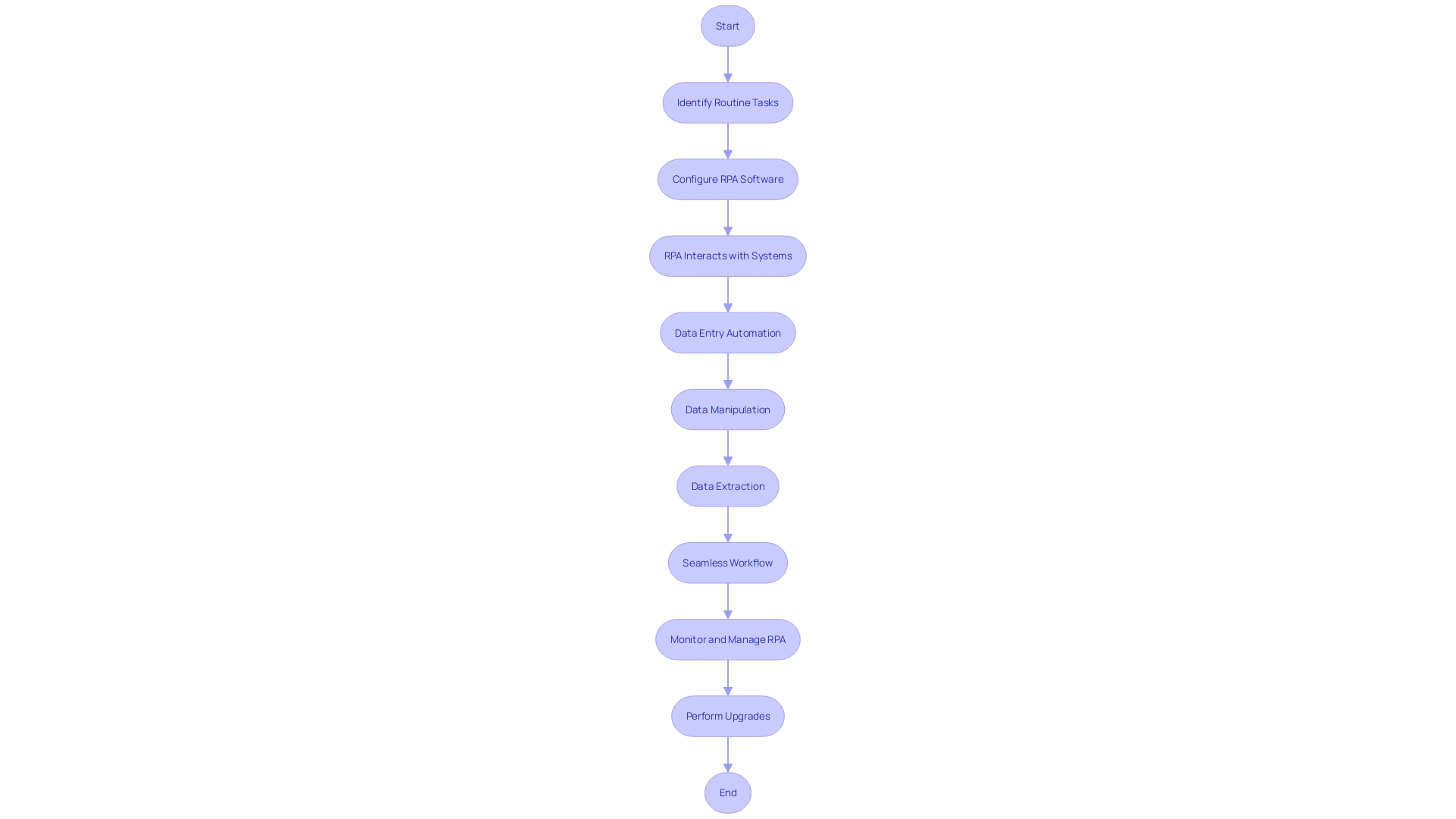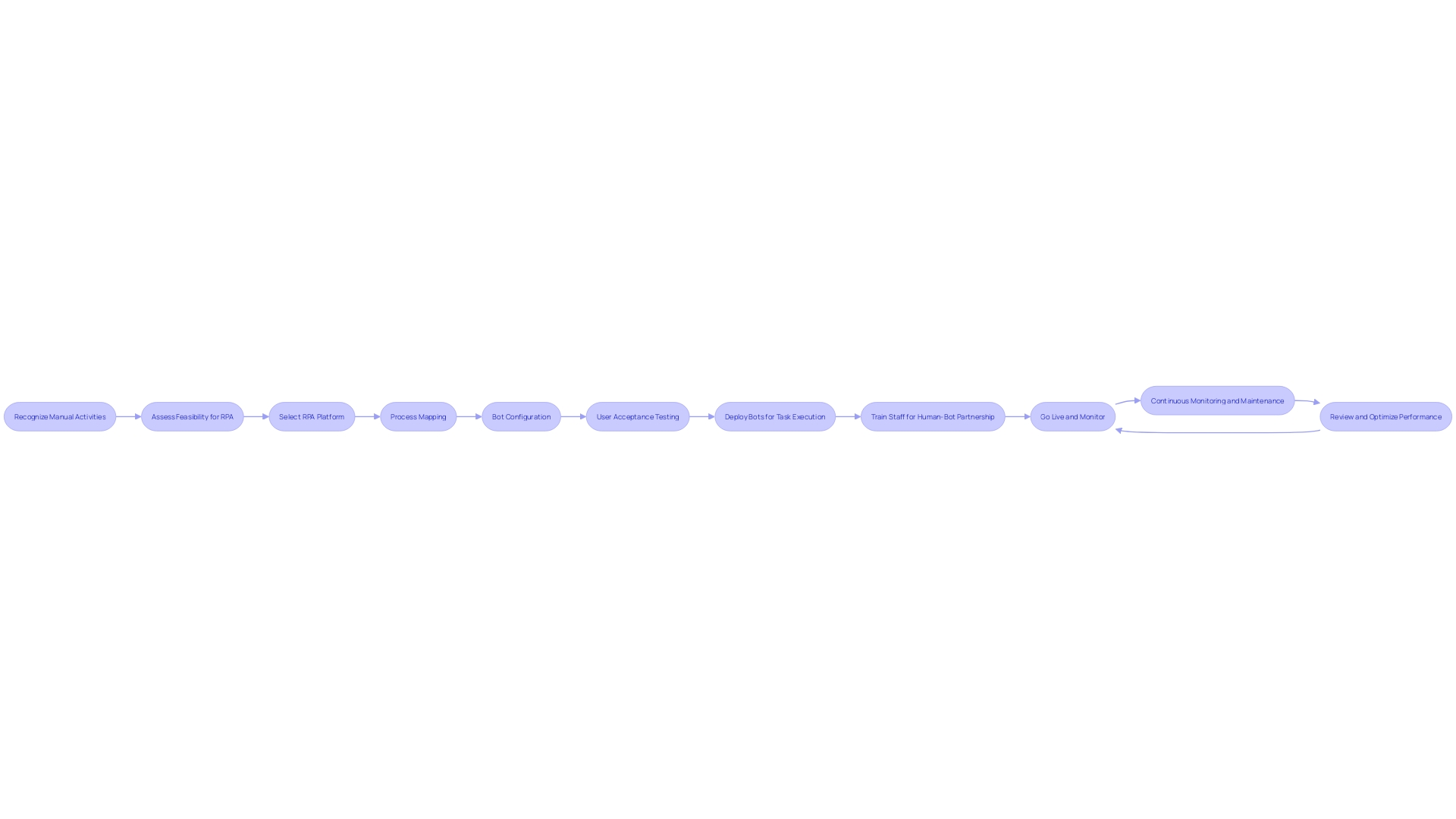Introduction
Robotic Process Automation (RPA) is a transformative technology that empowers organizations to automate routine tasks using software robots, or ‘bots’. These bots imitate human interactions with digital systems, performing functions like data entry and extraction with precision and speed. RPA seamlessly integrates with existing systems, enhancing business processes without the need for significant infrastructural changes.
This article explores the essence of RPA, its application in various industries, key features, and how it works. Discover how RPA is revolutionizing operational efficiency and empowering human resources to focus on more strategic initiatives.
What Does RPA Stand for?
Robotic Process Automation (RPA) represents a transformative technology that empowers organizations to automate routine, rule-based tasks through the use of software robots, or ‘bots’. These bots are capable of imitating human interactions with digital systems to perform functions such as data entry, manipulation, and extraction with precision and speed. Instead of needing extensive integration, RPA smoothly operates alongside existing systems, improving operational workflows without the need for significant infrastructural modifications. This not only introduces a high level of efficiency but also presents a cost-effective approach to process management.
For instance, Surrey County Council, serving over a million residents in England, has embraced automation to improve both citizen and employee experiences. In a similar vein, Louvre Hotels Group has harnessed the power of RPA to save hundreds of hours per month in maintaining rate code details, underscoring the technology’s potential to revolutionize operational efficiency in the hospitality industry.
The essence of RPA is its ability to connect disparate systems, creating a seamless workflow that liberates employees from monotonous tasks, allowing them to focus on more strategic initiatives. Automation technology is not a ‘set it and forget it’ solution; it requires ongoing monitoring and management to ensure optimal performance, something which aligns with the historical evolution of automation. From water wheels to AI, the goal has always been to enhance productivity and convenience, yet human oversight remains crucial.
As we navigate the future of automation, industry leaders like Coding Crafts highlight the importance of staying at the forefront of technological advancements. Their focus extends beyond RPA, incorporating services like Blockchain Development for enhanced security and transparency. With automation reshaping the technological landscape, it’s evident that RPA is not just a trend but a crucial tool in the modernization of organizational processes.

Full Form of RPA Explained
Robotic Process Automation (RPA) leverages the capabilities of software bots to perform activities that are repetitive and based on clear rules. These software applications are adept at emulating human interactions with digital systems to perform a variety of functions such as data entry, document processing, and data extraction. The essence of RPA is not to replace humans but to complement their efforts, enabling them to dedicate time to strategic roles that add greater value. With its roots in task automation and adherence to pre-established rules for operation, RPA is a key player in the modern landscape, particularly where efficiency and productivity are paramount.
A notable example of RPA’s application can be seen in the healthcare sector. For example, the adoption of new digital technologies within a clinical environment often starts with a request form submitted by clinicians to a Digital Service Team. This team conducts a thorough assessment to ensure compliance and suitability of the technology. Through such assessments and the deployment of AI chatbots, RPA is instrumental in easing staff shortages and enhancing patient care.
Moreover, embracing RPA requires a nuanced approach. As the CTO and Co-Founder of Reveille Software notes, automation, throughout its history, has never been a set-and-forget solution. It demands ongoing human oversight for monitoring, management, and improvements. This is equally true for RPA, which, while aiming to elevate efficiency and productivity, necessitates human partnership to maintain stability and adapt to evolving organizational requirements.
Workflow automation, closely related to RPA, leverages technology to streamline complex processes, thereby diminishing the need for manual intervention and reducing the likelihood of human error. It is embraced by enterprises that manage repetitive tasks, such as sending notifications or handling permissions. A study by Zapier reveals that this is a common scenario in smaller enterprises. Furthermore, Process Intelligence offers a strategic advantage by analyzing operational data to identify inefficiencies and predict potential issues before they escalate.
In summary, RPA is a transformative force in various industries, offering a strategic approach to process management. It is a technology that not only accelerates operational workflows but also empowers human resources to focus on more innovative and impactful work.
Key Features of RPA
Robotic Process Automation (RPA) is revolutionizing the way businesses operate by providing advanced tools for automating repetitive and rule-based activities. Leading this innovation are RPA bots, software entities designed to interact with digital systems and carry out activities with precision and efficiency. Here are some of the standout features that make RPA a game-changer for process automation:
-
UI Interaction: Mimicking human interactions with software applications, RPA bots can perform a variety of tasks such as data entry, navigating through interfaces, and clicking buttons, thereby bridging the gap between human users and digital processes.
-
Rule-Based Logic: By following pre-established rules and logic, RPA bots can handle structured data and make decisions, ensuring that activities are carried out consistently and in accordance with set parameters.
-
Scalability: The ability to scale RPA solutions up or down is a testament to their flexibility, allowing organizations to respond to changing demands and expanding workloads by deploying additional bots as needed.
-
Non-intrusive Integration: RPA’s non-invasive approach means it can seamlessly interact with existing systems, reducing the need for complex integrations and facilitating a smoother adoption of automation technologies.
-
Audit Trails and Monitoring: Providing transparency, RPA maintains detailed records of bot activities, which helps with regulatory compliance and provides valuable insights for improving procedures.
As the digital landscape evolves, companies like Coding Crafts are at the vanguard of integrating RPA with other cutting-edge technologies like Blockchain, enhancing security and transparency in automation efforts. This holistic approach to automation represents a leap forward in operational efficiency and opens up a myriad of possibilities for innovation in various industries.
How RPA Works
Robotic Process Automation (RPA) is revolutionizing the way businesses operate by automating manual, rule-based activities. Beginning with the recognition of such activities, the RPA expedition advances through comprehensive process mapping to comprehend the flow and dependencies of each undertaking. Configuring RPA bots involves establishing the rules, instructions, and parameters they’ll adhere to, which is followed by a critical training phase where bots acquire the necessary skills through demonstrations or guided instructions.
Once trained, RPA bots can autonomously execute tasks, interacting with the interfaces of target applications, performing actions, and managing any exceptions based on their configuration. However, the implementation of RPA isn’t a set-it-and-forget-it procedure. Continuous monitoring and maintenance are essential to address issues, fine-tune performance, and adapt to changing business needs.
For instance, within the Department of Electronic & Electrical Engineering, the process of recording attendance and student comments was ripe for RPA implementation. Another example is Lindy, an AI assistant platform that faced the challenge of integrating a network of apps and services to enable task execution. By addressing such challenges with RPA, businesses can streamline operations and focus on strategic initiatives.
Indeed, as the CTO and Co-Founder of Reveille Software pointed out, automation requires ongoing human partnership to ensure stability and achieve improvements in efficiency and productivity. Organizations are encouraged to assess their needs carefully, considering a pilot project and expert partnership for optimal RPA deployment and long-term success. With RPA’s ability to bridge various applications and platforms, it represents the next wave in technology, promising significant impacts on operational efficiency.

Conclusion
In conclusion, Robotic Process Automation (RPA) is a transformative technology that is revolutionizing operational efficiency in various industries. RPA empowers organizations to automate routine tasks using software robots, freeing up human resources to focus on more strategic initiatives.
RPA seamlessly integrates with existing systems, enhancing business processes without the need for significant infrastructural changes. It connects disparate systems, creating a seamless workflow that liberates employees from monotonous tasks. RPA is not just a trend but a pivotal tool in the modernization of business processes.
Key features of RPA include UI interaction, rule-based logic, scalability, non-intrusive integration, and audit trails and monitoring. RPA bots mimic human interactions with software applications, perform tasks consistently based on predefined rules, and can be scaled up or down to respond to changing demands. RPA’s non-invasive approach allows for seamless integration with existing systems and offers transparency through meticulous record-keeping.
The implementation of RPA involves identifying manual, rule-based tasks, mapping out processes, configuring bots, and training them to execute tasks autonomously. Continuous monitoring and maintenance are crucial for addressing issues and adapting to changing business needs. Organizations are encouraged to carefully assess their needs, consider pilot projects, and seek expert partnerships for optimal RPA deployment and long-term success.
Overall, RPA is empowering businesses to streamline operations, enhance productivity, and focus on strategic initiatives. By embracing RPA, organizations can unlock the full potential of automation and drive significant impacts on operational efficiency.

